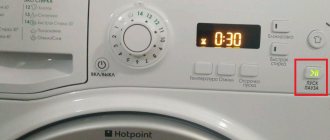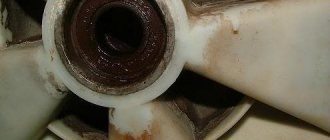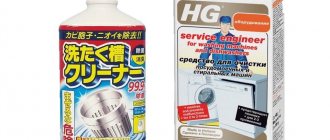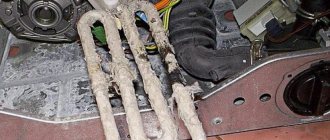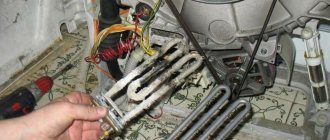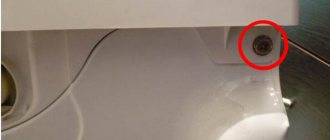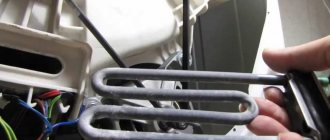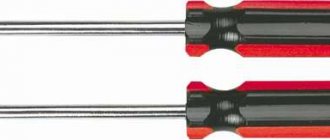For heating water? Washing machines use a tubular element with a spiral that burns out during operation. The heating element in the Ariston washing machine is replaced by a specialized service center, but the owner can install the element himself. To remove a worn heating block, you will need to partially disassemble the machine body.
Causes of failure
This type of washing machine malfunction can be considered the simplest possible, since replacing the heating element does not require complete or even partial disassembly of the machine. Although most often the heating element in the washing machine is to blame for the lack of heating, there are often cases when the cause of the breakdown is the heater wires, and not the heater itself. Therefore, you should check them first.
A heating element is a tubular electric heater in the form of a curved metal tube, inside of which there is a conductive thread in an insulator. This thread experiences serious loads when heated and cooled, so it is most often the first to fail.
Another reason for the malfunction of the heating element may be the formation of scale. Covered with scale, it heats water very poorly and at the same time overheats itself, consuming a lot of excess electricity. In addition, scale can damage not only the heating element itself, but also the drum of the washing machine. This scourge cannot be completely avoided, but you can slow down the process of scale formation if you wash your clothes using special chemicals to remove scale or “soften” the water. Read about how to descale heating elements here.
Even less often, the programmer or temperature sensor in the heating element may be to blame for the lack of water heating in the washing machine. To exclude these options, you need to take an electrical tester (multimeter) and “ring” the contacts of the heating element. If this cannot be done, then feel free to proceed with replacing it. On our website you can find a detailed algorithm for checking the heating element and temperature sensor.
When to change TEN
The electric heater located inside the equipment housing is exposed to tap water. Scale forms on the surface of the metal tube, impairing heat transfer. The heated spiral gradually collapses, and if the element breaks, the heater turns off.
An additional problem is damage to the insulator, leading to electrical breakdown and tripping of fuses (short circuit).
In both cases, the heating element must be replaced; the device cannot be repaired or restored.
Tools
Changing the heating element in a Samsung, Ariston, etc. washing machine is quite simple. To do this, just open the rear hatch, find the heater inside, disconnect the wires from it, unscrew the fastening bolt and replace the faulty part. For this we only need:
- Screwdriver Set;
- a tubular or wrench of a suitable size;
- pliers.
The heating element replacement described below is applicable to any model of LG, Samsung, Bosh or Indesit washing machines. It doesn’t even matter whether your machine loads laundry horizontally or vertically. The principle and procedure are the same in all cases.
Device Models
In machines from this manufacturer, the heater is often located at the back. The contacts come out, but most of the spiral is hidden inside the housing. It’s difficult to get confused - the device of this brand has a direct-drive motor, which is attached to the tank, and the heating element is under the tank. The case does not require extensive disassembly.
Here the heater will be located at the back. Close the inlet valve before work, disconnect communications. The rear wall of the Indesit machines has a small hatch. Prepare a shaped screwdriver or an asterisk. The heating element is secured inside with a special bracket: make sure that the part fits directly into the bracket.
The heating element is located on the flange (together with the fuse). While the heaters of other machines can be repaired, this is not possible in Samsung machines - you will need to buy a new one. Price - in the range of 700–1500 rubles.
Procedure
So, let's see how to replace the heating element in a washing machine using the Indesit brand as an example. In the same way, you can replace the heating element on washing machines Bosch, LG, Samsung and others.
First you need to find the place where the heating element is located - in different models of machines it can be located either in the back of the tank or in the front. If your equipment has a special hatch on the rear wall for access to its internal components and it is large enough, then most likely the heating element should be located there. If not, then look for it below the front wall.
The location of the heating element is indicated by the wires going to the tank from the power supply.
The heating element itself is installed inside the tank; from the outside we can only see the terminals with wires and the temperature sensor, which is installed in the heater.
Having disconnected all the wires and the sensor from it, we can begin to remove it from the tank.
Before removing the heating element, do not forget to drain the remaining water from the machine tank through the drain filter.
To remove the heating element in an LG, Bosch or Samsung washing machine, you need to partially unscrew its central nut, and then push its threaded pin inward until it stops using a screwdriver, pliers, hammer or other suitable tool.
Since the heating element “sits” very tightly on the rubber gasket, it will not be possible to simply remove it by hand. First you need to carefully pry its edges with a slotted screwdriver and try to remove the thick rubber gasket that prevents you from reaching the heater.
The heating element should be removed very carefully. This may take quite some time, so be patient. Gradually push it out by swinging it in different directions, helping yourself with a screwdriver.
Having removed the faulty heating element, you have done half the work. Now you also need to patiently and tightly install the new heater into the seat of the old one, without allowing distortions and displacements (some tanks have special guides for this). Then tighten the nut and connect the wires to the terminals of the heating element in the same way as they were connected earlier.
It is very important not to twist the stud nut - if you overtighten it, the heating element of the heating element may fall into the drum!
After replacing the heating element, you must immediately check its operation. To do this, you need to run the washing machine “idle”, setting the water heating temperature to 60-80 degrees. If the heating element operates properly for 30 minutes. The window glass of the car should warm up slightly.
Checking the heating element with a multimeter.
Here is the heating element itself (heating element).
We remove the power terminals and check the heating element with a multimeter (tester). We measure the resistance in Ohms, the operating resistance should be approximately 30 Ohms.
The tester does not show any resistance, which means the heating element is “broken,” that is, it is faulty. The Ariston heating element needs to be replaced. With such a defect, the machine will fully work out the mode, but the wash will take place with cold water. That is why things will not wash well.
In a particular case, it also happens that the heater “does not break off”, but begins to short-circuit to the housing. In this case, the Ariston washing machine will not fully complete the washing cycle. It will stop and display error F08 (error codes can be viewed here) before rinsing begins. When checking the heating element with a multimeter, the resistance at the ends will also be normal (approximately 25-30 Ohms), but when measuring the resistance between the ends and the body (ground) at Mega Ohms, the tester will show a resistance from 1 MOhm to 200 MOhm. In this case, you will also need to replace the heater.
Conclusion
Now you know how to change the heating element in a washing machine from LG, Bosch, Samsung, Indesit, Ariston, etc. It is recommended to check the heater every three to four months. You need to buy a new heating element specifically for your machine model. It is best to do this on the manufacturer’s website or at a service center (where, by the way, you can get a new heating element under warranty).
It costs differently everywhere and no matter how much! Remember that operating a washing machine with a faulty heating element can lead to damage to the programmer. And this is even more expensive.
How to tell if the heating element is not working
Due to the fact that it is impossible to open the tank during washing, you should find out about a breakdown of the heating element by indirect signs.
You can roughly calculate the time for draining dirty water into the sewer before rinsing and at this moment touch the surface of the hose. If it is warm, everything is normal, if it is cold, then the heater needs to be changed. But not everyone has the opportunity to do this. By what other signs can you notice a breakdown of the heating element?
- The quality of washing has deteriorated sharply. Moreover, it does not increase when replacing the washing powder used and increasing the heating temperature on the control panel.
- Electrical energy consumption during washing has been significantly reduced. We must remember that the machine uses at least 80% of all energy to heat water.
- The washing machine turns off on its own or the circuit breakers of the protective electrical fittings are triggered. Such situations are observed when filling the machine with water. If this happens to you, immediately disconnect the device from the power supply and do not use it until repaired.
If the quality of the wash has sharply deteriorated, you need to check whether the heating element is working
Important. Unfortunately, most domestic houses and apartments of old projects do not have grounding, which significantly increases the risk of injury. At the first sign of problems with short circuits, you should turn off the electrical equipment as quickly as possible and call a professional electrician, or fix the problem yourself. But for this you need to have special tools and devices, and know the requirements of the PUE.
Washing machine heating element device
Installation and connection methods
“Dry” heating element
A heating element is a device that requires regular maintenance. After a while, it needs to be cleaned or replaced, depending on the efficiency and completeness of the work.
To clean the heating element yourself, you need to follow the instructions:
- Turn off the electric water heater.
- Disconnect the electric heater from the power supply.
- Open the protective panel by unscrewing the screws.
- Under the panel where the thermostat and colored wires are located, disconnect the cables.
- Shut off the water supply to the water supply and boiler.
- Pull out the thermostat along with the heating element, removing the flange if necessary. At the same time, place a container near the opening in case there is water in the tank. Unscrew the heating element using an adjustable wrench.
- Dissolve two packets of citric acid in two liters of water.
- Immerse the heating element in the resulting solution and leave for at least 12 hours. After some time, the heating element is ready for installation.
- Install in reverse order.
To check the correct installation of the heating element, you will need to turn on the water. If liquid leaks from the tank, the device is not connected correctly.
There are three main ways to connect a heating element for an Ariston water heater. Sequential - the heater power depends on the total power of each element. The disadvantage is that if one heating element breaks down, the functionality of the entire heating system is lost.
Parallel - allows you to maintain the functionality of the unit in the event of failure of one of the heating elements. Combined - usually used if heating elements of the required power are not available.
Removing the control panel of the washing machine
First, we take out the cuvette for the powder - pull it out, press the button inside and finally pull it out. For models that do not have a locking key in the cuvette, pull it all the way, slightly up and out of the grooves.
Two or three screws become visible. We delete them. Now you need to unscrew the remaining screws that hold the control panel in place. They can be on top or on the sides. After unscrewing these screws, carefully remove the panel. We leave it hanging on the wires. For convenience, let's put the panel up.
Separate the hatch cuff
To do this, open the door of the washing machine. Take a screwdriver and carefully pry up the spring clamp that secures the rubber cuff. Remove the clamp by pulling it in a circle. Now we remove the rubber from the body of the front wall of the washing machine with our hands. The hatch lock can be secured with screws or latches. Unscrew or remove the clamps and push the lock inside.
Disassembling the Ariston water heater
If for any reason you need to disassemble the boiler yourself, then do it using the proposed step-by-step technology:
Figure 3. Diagram of the heating element.
disconnect the water heater from the network; drain the water from the tank through the drain valve and the valve on the hot water pipe; unscrew the thermostat from the terminals and remove it; remove the heating element - to do this, unscrew the bracket holding it and remove the heater from the socket (do not forget to place a bucket under the Ariston to drain the remaining water), Figure 3; to further disassemble the boiler, remove it from its mountings and carefully lower it to the floor, placing the water heater upside down; Unscrew the flange and remove the gasket.
The tank is cleaned of scale - it usually accumulates at the bottom. This process is done manually and the container is then washed. They inspect the magnesium electrode - if it is in order, then proceed to check the heating element. Scale and rust (if any) are removed from it. They check the integrity of the spiral using a tester, and if it is damaged, then buy a new heating element and install it when assembling the water heater.
Inspect the gasket and, if it is dry, install a new one.
If upon inspection of the flange you find damage or it is rusty, buy a new one at the store and install it.
Expert advice
- If you don’t want to get tangled up in bolts, nuts, and parts, don’t throw anything at your feet. Place the ingredients carefully. You can take photos with your phone before each stage, and at the end, while assembling, check the photo. This will help you do everything right.
- Some heating elements have temperature sensors. They react poorly to impacts, even weak ones, so handle the parts with extreme care.
- Do not use sharp objects when cleaning the internal parts, but it is useful to soak the heating element itself in a solution of citric acid.
There is already a washing machine in almost every apartment or house. If previously such equipment was a sign of wealth, now its absence causes bewilderment: how can a housewife do without such a necessary thing?
In order for the machine to last as long as possible, it is worth studying the basic rules of care and repair. After all, it is not always possible to find a specialized workshop nearby with a good, conscientious craftsman. Replacing a heating element is one of the simplest repairs: you can handle everything yourself.
